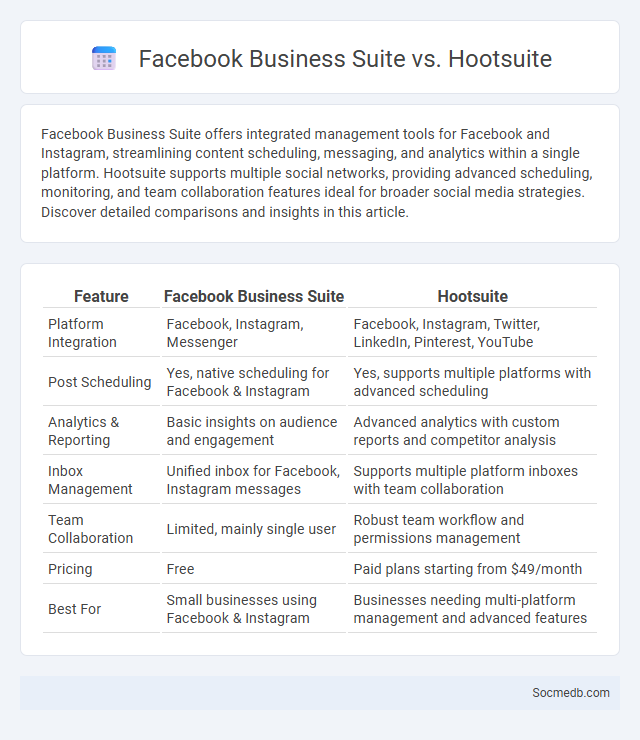
Photo illustration: Facebook Business Suite vs Hootsuite
Facebook Business Suite offers integrated management tools for Facebook and Instagram, streamlining content scheduling, messaging, and analytics within a single platform. Hootsuite supports multiple social networks, providing advanced scheduling, monitoring, and team collaboration features ideal for broader social media strategies. Discover detailed comparisons and insights in this article.
Table of Comparison
| Feature | Facebook Business Suite | Hootsuite |
|---|---|---|
| Platform Integration | Facebook, Instagram, Messenger | Facebook, Instagram, Twitter, LinkedIn, Pinterest, YouTube |
| Post Scheduling | Yes, native scheduling for Facebook & Instagram | Yes, supports multiple platforms with advanced scheduling |
| Analytics & Reporting | Basic insights on audience and engagement | Advanced analytics with custom reports and competitor analysis |
| Inbox Management | Unified inbox for Facebook, Instagram messages | Supports multiple platform inboxes with team collaboration |
| Team Collaboration | Limited, mainly single user | Robust team workflow and permissions management |
| Pricing | Free | Paid plans starting from $49/month |
| Best For | Small businesses using Facebook & Instagram | Businesses needing multi-platform management and advanced features |
Overview: Facebook Business Suite vs Hootsuite vs Meta Business Suite
Facebook Business Suite (now Meta Business Suite) and Hootsuite are powerful tools for managing social media, with Meta Business Suite offering streamlined integration across Facebook, Instagram, and Messenger for unified content scheduling, messaging, and analytics. Hootsuite supports a wider range of platforms including Twitter, LinkedIn, and YouTube, featuring advanced analytics, team collaboration, and a customizable dashboard that caters to diverse social media strategies. Both platforms prioritize user-friendly interfaces but differ in scope, with Meta Business Suite optimized for Meta's ecosystem, while Hootsuite provides broader multi-platform management capabilities.
Key Features Comparison
Social media platforms differ significantly in their key features, such as content formats, user engagement tools, and privacy settings. Instagram excels in visual content sharing with Stories and Reels, while Twitter prioritizes real-time updates and concise text-based posts through tweets. LinkedIn focuses on professional networking with detailed profiles, job postings, and industry-specific groups, offering distinct advantages for career-oriented users.
Supported Social Media Platforms
Supported social media platforms include Facebook, Instagram, Twitter, LinkedIn, TikTok, and Pinterest, each offering unique features to enhance your online presence. These platforms support various content formats such as images, videos, stories, and live streams, enabling effective audience engagement. Leveraging multiple platforms can maximize reach and improve brand visibility across diverse user demographics.
User Interface and Experience
A well-designed social media user interface enhances navigation by providing intuitive layouts and clear visual hierarchies, reducing friction for Your interactions. Optimizing loading speeds and minimizing intrusive elements significantly improve the overall user experience, encouraging longer engagement. Personalization through AI-driven content recommendations and adaptive design ensures that the platform feels relevant and accessible across all devices.
Content Scheduling Capabilities
Content scheduling capabilities on social media platforms enable businesses to plan and automate posts across multiple channels, ensuring consistent audience engagement. Advanced tools offer features like optimal posting time recommendations, recurring content options, and detailed analytics to track performance. Efficient content scheduling reduces manual effort, increases reach, and enhances strategic marketing outcomes.
Analytics and Reporting Tools
Social media Analytics and Reporting Tools provide in-depth insights into audience behavior, engagement metrics, and content performance across platforms like Facebook, Instagram, and Twitter. Tools such as Google Analytics, Sprout Social, and Hootsuite enable marketers to track real-time data, measure ROI, and optimize campaign strategies effectively. By leveraging these analytics, businesses can make data-driven decisions to enhance user engagement and increase conversion rates.
Pricing and Subscription Plans
Social media platforms offer a range of pricing and subscription plans tailored to different user needs, from free basic access to premium tiers with advanced features such as ad-free browsing, exclusive content, and enhanced analytics. Businesses can subscribe to specialized packages that include targeted advertising options, detailed audience insights, and priority customer support, maximizing your marketing impact. Understanding these plans helps you choose the best value option that aligns with your goals and budget.
Team Collaboration Options
Social media platforms offer a variety of team collaboration options, including real-time messaging, shared workspaces, and project management tools that streamline communication and task coordination. You can integrate apps like Slack, Microsoft Teams, or Trello within social media environments to enhance productivity and foster seamless teamwork. These features enable teams to collaborate efficiently, track progress, and share feedback in a centralized digital space.
Integration with Third-Party Apps
Integrating social media platforms with third-party apps enhances your ability to manage content, streamline communication, and analyze engagement across multiple channels. Popular integrations include scheduling tools like Hootsuite, analytics platforms such as Google Analytics, and customer relationship management (CRM) systems like Salesforce. These connections optimize workflow efficiency and provide comprehensive insights into audience behavior.
Pros and Cons Summary
Social media offers powerful tools for connecting with others, boosting brand awareness, and accessing real-time information, enhancing both personal and professional networks. Your digital presence can benefit from increased engagement and targeted advertising, leading to growth opportunities and community building. However, it also poses risks such as privacy concerns, misinformation, and potential negative impacts on mental health, requiring mindful usage to maximize benefits and minimize drawbacks.
 socmedb.com
socmedb.com